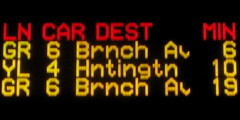Riding on (and capacity of) the Metro
_________
Updated because of the mention in Free Ride/The Express. Image by Eye Captain.
_________
Today's Post has an article, ""New Rail Cars Coming To Carry Record Crowds" about the new cars expected. This will allow for a greater number of 6 and 8 car trains.
But it's only an interim solution. From the article:
"We're continuing to reap both the benefits and costs of success," Tangherlini said. The success of the region, with its low unemployment rate and the country's second-highest average household income, is also putting a strain on Metro, he said.
"The train cars aren't getting bigger," Tangherlini said. "We're trying to get more out there and make sure our aging fleet of rail cars is able to be out there every day."
Metro's ridership has increased 40 percent in the past 10 years, he said. If Metro shifted to running only eight-car trains, "you could argue that we are another 10 years from filling them up." After that, he added, "we begin to run out of bunnies to pull out of the hat."
Adding transit capacity in the core of the city needs to be put on the regional planning agenda. We can't afford to wait to deal with this in ten years, when maximum capacity is reached.
______
New text: I wrote about this (and really the Post wrote about this) extensively in a blog entry in July, "Transit without borders or five omissions "in" the Transportation Element of the DC "Comprehensive" Plan." Here's point one:
1. Regardless of the cost, the idea of adding capacity to the subway system, along the lines of the long since dropped separate blue line proposal from 2001-2002 (and earlier), needs to be put back on the table.
The subway system is getting great usage. It needs more cars and a better intra-car seating configuration to get more throughput. But at some point, only so many trains can get through the system, based on the current configuration. One issue is the subway tunnel at Rosslyn. But another is that there are only two tracks. For redundancy and throughput purposes, this must be addressed.
Dan Tangherlini brought up streetcars as a way to improve intra-city transit, in response to the WMATA plan, because he said that it won't be possible to raise the money to create this separate line (which had two proposed H Street NE stations by the way). But it needs to be reconsidered.
See:
-- "Coming to a Curve: Region's Subway System Begins to Show Its Age, Limits" By Lyndsey Layton, Washington Post, March 25, 2001; Page A01
-- "Crowds Could Derail Decades of Progress," By Lyndsey Layton, Washington Post, March 26, 2001; Page A01.
From this article:
Many of Metro's capacity problems can be traced to its design. It was built as a two-track railroad, with five lines stretching from the city core to the suburbs in a hub-and-spoke arrangement.
The two-track design means big trouble when a train breaks down. The train has to be hauled down the track until it reaches one of just a few sidings where it can be pulled off the main track. That slows movement on the entire line and explains why a breakdown at Farragut North can affect passengers waiting for trains at Union Station.
"We're like a two-lane country road with no breakdown lane," White said. The two-track railroad also prevents Metro from running express trains. And 24-hour service is out of the question, because Metro needs to shut down its system several hours a day to perform track maintenance. Larger systems such as New York's, which has up to six tracks at some stations, can perform maintenance on two tracks while running service on others, and can operate round-the-clock.
The other crucial flaw is the fact that four of Metro's lines share track for significant stretches. The Orange and Blue lines, for instance, merge at Rosslyn, then share track through a tunnel under the Potomac River and across downtown Washington until they separate at the Stadium-Armory Station.
Forcing the lines to share track cuts the capacity of each by half and is the main reason inbound Orange Line trains at, say, West Falls Church are standing room only during rush hour. Because a certain distance must be maintained between trains, there's a limit to the number of trains that can be sent down the Orange and Blue track each hour. Plans to extend rail service to Dulles and Tysons Corner may help ease crowding on the roads in an area that lacks rail service. But lengthening the Orange Line to Dulles will exacerbate crowding, by reducing the capacity of the Orange and Blue lines even further.
-- "Metro Construction Projects Creak to Halt; Economic, Political Changes Cancel Expansion Plans, Spur Job Cuts, Early Retirements," Lyndsey Layton. Washington Post, July 13, 2003. pg. C.01. (I can't find this story online.) From the article:
Metro headquarters pulsed with big plans. P. Takis Salpeas, the head of construction, was swimming in fresh designs: rail to Tysons and Dulles, a Purple Line that would circle the city, a rail line over the new Woodrow Wilson Bridge, a new subway line through downtown that would finally bring Metro to Georgetown and release the railroad's choke points.
That was two years ago. Today, those plans have largely evaporated, victims of a soured economy and fractured local politics. Metro is not building the next generation of transit -- it is barely able to run its existing system. As construction money dwindles from the current fiscal year through fiscal 2009, Metro's stable of well-regarded architects, engineers and construction managers will be cut from 237 to 23.
Index Keywords: transit




0 Comments:
Post a Comment
<< Home